Marketers like to try new things. One of the reasons many of us got into this profession is the ever-changing nature of it and the fact that there is always innovation: new channels, tools, tactics and technology to learn and master.
Just in the last few years, we’ve seen the marketing technology landscape grow to include more than 7,000 different solutions.
But rolling out something new isn’t as easy as flipping a switch. Before initiatives are debuted, they require two things: budget approval and buy-in from the executive team.
This is especially true when companies launch a new marketing effort. Let’s say you have an original campaign that you’re sure will resonate with customers. You think it could propel your organization ahead of the competition and set the stage for future growth.
The best way forward is to test your hunch before investing too much of your budget in an unproven message, channel or tactic. Running a sample campaign and measuring the results will help you either prove that it worked and/or iterate to improve outcomes.
By making a direct connection between your advertising efforts and actual sales, you’ll have the proof to win over leadership and get the resources you need to scale up.
In the past, marketers have relied on historical campaign data to build a case for future initiatives. This data included traditional metrics such as clicks, using last touch attribution.
But in today’s hyper-competitive world, relying on old school metrics won’t give you the insight you need. You want to understand and prove the real impact of advertising—in dollars, not clicks.
Use Incrementality to Prove Your Value
Marketers in every industry have one common goal: Prove that marketing efforts help drive more revenue. In other words, you need to demonstrate that your tactics motivated buyers to take some action—visit your site, request a quote and/or plunk down their hard-earned money.
One way you can do this is by measuring incrementality. People use the word “incrementality” to mean different things. Strictly defined, it’s the lift that marketing and advertising provide above native demand—the increase in leads, sales and other key performance indicators (KPIs) gained that would not have occurred without marketing efforts.
Native demand refers to sales that happen without marketing influence. Depending on your product, there are always some people who will buy it, even if you don’t advertise. Think paper towels, light bulbs and socks. People buy most of these products due to native demand—the result of long-term brand awareness, basic needs and outside factors.
A brand’s marketing efforts are designed to increase two things: the number of people aware of a product and the number of units sold. The difference between native demand and ad-driven sales represents incremental lift—the increase in sales that’s attributable to your marketing efforts.
Make Smarter Optimization Decisions
Measuring incremental lift helps marketers understand and prove the real impact of advertising.
There are many methods for measuring incrementality, including looking at conversions before and after your marketing efforts. But the only true way to measure causality is to use a more sophisticated approach.
Testing channels or campaigns, then comparing the sales metrics based on actual response or purchase data for two groups of your buyers—those who saw your ads and those who did not—will give you the most accurate view of the incremental sales lift.
For marketing research analysts, brand managers and channel managers, measuring lift provides powerful insights into the consumer segments and campaign elements that are driving the greatest response, so you can make smarter decisions going forward.
Testing will help you answer critical questions about the performance of your campaigns:
- Did my campaign have positive impact on in-store and online sales?
- Did my campaign have a positive return on ad spend?
- What impact did it have on existing brand buyers versus new brand buyers?
- Is the campaign driving more buyers, higher purchase frequency and higher basket size?
- Which audience segments had the strongest response?
- What impact did the campaign have on my market share?
Once you can quantify the incremental sales impact driven by your advertising, you’ll be able to optimize your future media buys based on actual sales metrics. Most importantly, you’ll get the proof you need to end the debate over marketing value and return on advertising spend.
Benefits of Measuring Incrementality
Understanding incrementality allows you to optimize your budget by helping you allocate spend in the most effective way possible. An additional benefit of measuring incrementality is that you can see which audience segments should receive increased spend and which should not.
Segments that demonstrate higher incremental lift are those that were more influenced by your marketing. Those that have lower incremental lift were less influenced. By understanding each customer journey, marketers can better optimize where they spend their dollars.
Incremental lift can also indicate whether your marketing is working with a particular segment. If you’re trying to reach a certain audience (for example, a competitor’s customers) and there isn’t a strong lift with that group, you can change your messaging (or offer) to reach them more effectively.
Understanding incrementality is a new way of viewing performance for those accustomed to a click-based attribution model. When implemented correctly, incrementality can boost a brand’s revenue and help marketers prove their value.



